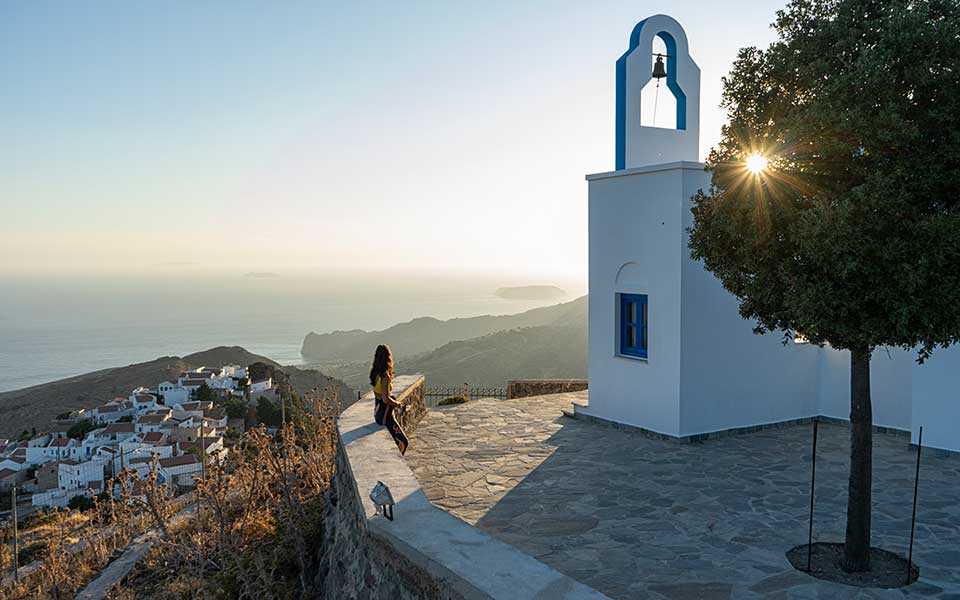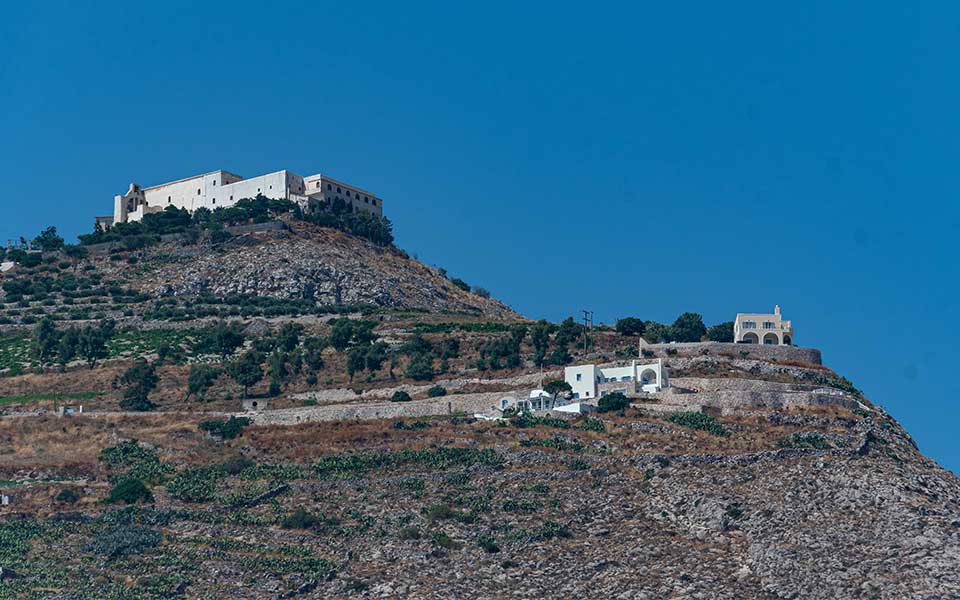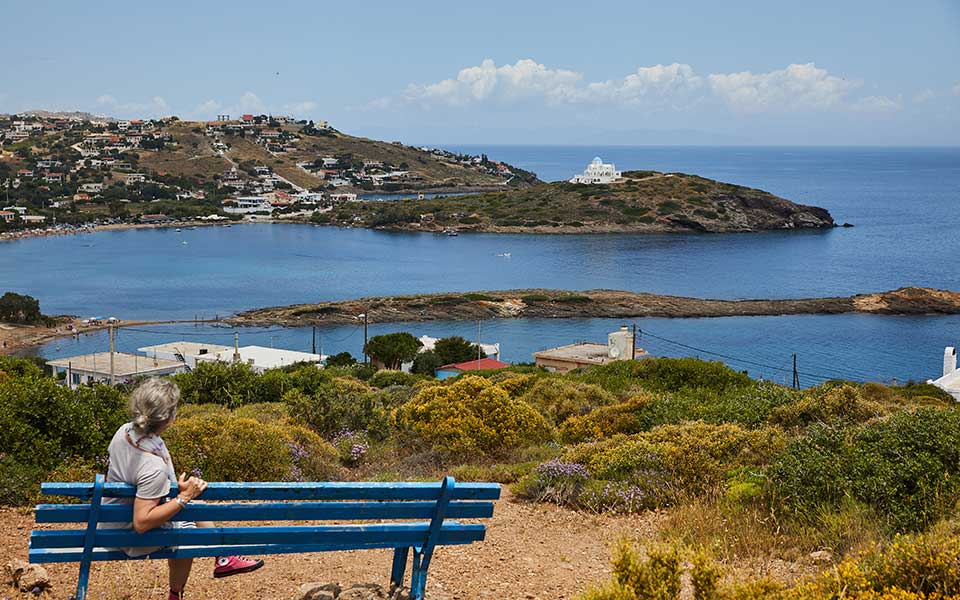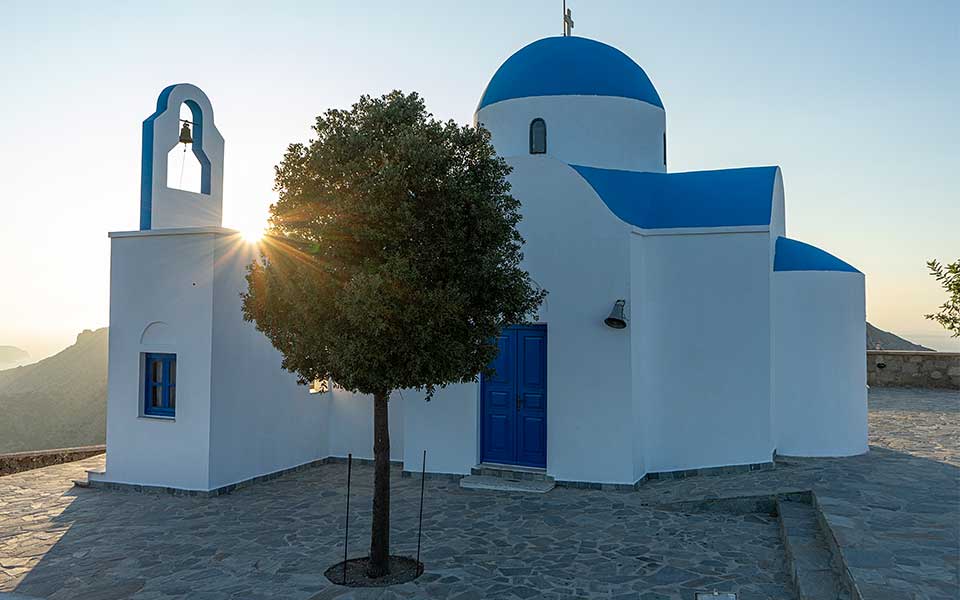Margarites: The Potters’ Village of Rethymno
In Margarites, Crete’s historic pottery village,...

Profitis Ilias, Nisyros island
© Marika Tsouderou
The religious sentiment of Greeks and the variety of ways in which their connection with the divine is expressed are well known. Many a visitor has been impressed by the sheer number of churches in Greece, especially on the islands, which have been built over time to honor the hundreds of saints of Christianity.
On many islands, there are almost as many churches as there are family homes. In many cases, the characteristic, small white houses will share a wall with an equally small white church, built in the same traditional style as the rest of the village.
And wherever you may find yourself in Greece, if you look to the surrounding mountains or hills, you will usually notice a small white dot on top of a peak: another church.
If you ask the locals which saint is honored up there, you will get the same answer every time, whether you are on mainland Greece or on an island: Profitis Ilias (the Prophet Elijah), whose feast day is celebrated around the country on July 20 – in the heart of the summer.
You might be wondering, with reason: Why is it always the Prophet Elijah who is honored in the highest and most remote locations?
This is where the written tradition of the Old Testament, as well as age-old oral popular tradition, comes in. Let’s go through the reasons one by one.

Profitis Ilias, Santorini island
© Shutterstock
According to the Old Testament, Elijah was a prominent Jewish spiritual figure who lived in the 9th or 10th century BC; he predicted the birth of Christ 816 years in advance. His Hebrew name was Eliyahu; Ilias, or Elias, is the Hellenized version.
Variations of his name exist in every language spoken in the East. He had the gift of miraculous powers, which he used to drive out pagans and their symbols, impose moral behavior and punish offenders. It is said that he once brought on a drought for three-and-half years, at the end of which he opened up the heavens and let the rain fall in abundance. The text mentions specific miracles that he performed and asserts that Elijah did not die, but rather was taken up to heaven on a fiery chariot.
Popular tradition cemented Elijah’s connection with natural phenomena, naming him master of rain, thunder, and lightning – phenomena which are most intense on mountains and summits. What’s more, his celebration on July 20 links him to the dangers of sunburn and powerful summer storms.
According to some tellings, the worship of Elijah effectively filled the gap left by Zeus, the ancient Greek god, the cloud gatherer, lord of the sun, lightning and winds, and master of time; Zeus was also celebrated around the same time as the feast day of Elijah.
So, according to popular tradition, the fact that the Prophet Elijah is worshiped on mountaintops is related to some extent to the ancient Greek belief system. This Old Testament prophet and Church saint was quite naturally associated with the sun (helios in Greek), as the sound of his name was similar to the word for the life-giving, celestial body.

Profitis Ilias, Lavrio
© Dimitris Vlaikos
It is also said that it was Elijah himself who chose the mountains as his place of worship. He is said to have been a sailor whom the sea had attempted to drown many times; he thus thought that he had to find a place where people had never heard about the sea, nor about boats. So, he started walking around with a paddle on his shoulder, asking anyone he crossed paths with if they knew what he was carrying. He eventually reached a high mountain, where a shepherd told him that he was carrying a piece of wood; that’s when Elijah knew that he had found the safest and most remote place from the dangerous sea.
These age-old perceptions played a key role in the creation of churches dedicated to the saint on top of mountains and hills. These are usually small, humble churches, with few icons and little decoration as they remain unguarded for many months of the year, exposed to potential looters.
These churches also may remain silent for many months – and perhaps even inaccessible due to weather conditions. But, during summer, this changes. For one, they become popular destinations among Greek and foreign hikers alike. The walking paths that lead to the many Profitis Iliases around the country usually offer spectacular views while being relatively easy hikes.
And, of course, there is the July 20 feast day. The Great Vespers begin one day prior, and the Divine Liturgy starts early in the morning of the feast day. The evening feast gathers a lot of people who often stay up until dawn. Often, it ends with a “kourbani,” a festive meal cooked for everyone, including foreign visitors, providing the opportunity for all to experience the local popular tradition.
Below are some notable churches dedicated to the Prophet Elijah on the islands and in mainland Greece.

Profitis Ilias, Nisyros island
© Marika Tsouderou
This Profitis Ilias church is located on the main hill of the town of Episkopio, or Piskopio. The wall plate on the church’s lintel states that it was reconstructed in 1845. It is certain that there was already a church in poor condition on the site, which was restored on the hill – private land owned by the Metaxas family. It houses exquisite icons by the painter Nestor Varveris.
The church of Profitis Ilias is found on a hill located just outside Nikia village. Locals consider it to be the most beautiful church in the Aegean. The view from the churchyard is unique, including vistas of both the volcano and the vastness of the Aegean. Visitors often sit on the stone wall around the courtyard enjoying the area’s absolute calm, which is particularly magical at sunset.
At an elevation of 680 meters, on Sifnos’ highest point, stands the Monastery of Profitis Ilias tou Psilou (meaning “Prophet Elijah of the Tall”), which is the most popular attraction of the island’s interior. Its church sits atop the very few remains of the island’s ancient acropolis, located very close to the village of Katavati. Although the existing church was built in the 17th century, the date 1145 is engraved in fragments of an iconostasis in the churchyard, evidently belonging to an older church that previously stood at this location. The monastery is accessible via a passable footpath that offers superb views. It is well worth attending the traditional festival honoring the saint, which begins on the eve of his actual feast day.
In 1937, the residents of Antiparos decided to build a church on the island’s highest point, which reaches an elevation of 308 meters. They built a true gem which they devoted to the Prophet Elijah. It offers a view that is breathtaking and endless, just like the serenity that reigns over this place.
The Monastery of Profitis Ilias is found at the top of the mountain that bears the same name, at an elevation of 567 meters, 3 km away from Pyrgos village, in the southeast of Santorini. It was founded in 1711. Throughout its history, the monastery has been a leader in ecclesiastical, educational, national and social matters. A ban on women was in place for many years, but women can now enter the church as well as the guest hall. No one should miss out on a visit to the monastery or on participating in the saint’s feast day.
Lavrio’s whitewashed church of Profitis Ilias stands atop a hill overlooking the beach of Aghia Marina. Considered one of the most beautiful churches in the region of Attica, it is a popular place for weddings for Athenians. Particularly on summer nights, with atmospheric lighting, the overall scene is positively enchanting.
The celebrations and festival dedicated to the Prophet Elijah in Agiasos, Lesvos, can be traced back to the Greek War of Independence. A local equine ritual has undergone many variations over time, but we will stick to the current version: On the eve of the festival, riders prepare their horses, and on the saint’s feast day they ride to Olympos mountain, where the church is located, carrying the icon of the prophet which is normally kept in the church of Aghia Triada (Holy Trinity) in Agiasos. After the service, they ride back to the small town to return the icon; the priest then blesses meat prepared for the occasion, and a large gathering of locals and visitors alike enjoy much feasting and revelry.
In Margarites, Crete’s historic pottery village,...
A Polish-born artist who lives on...
Discover how Christos, Athens’ master souvlaki...
Recycling is an age-old tradition in...